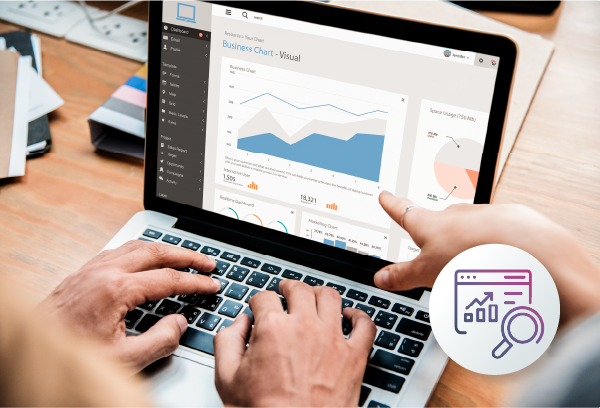Data is the output of most of our online interactions, and it’s no different when it comes to eLearning. The world of Big Data in education is changing the way we experience learning. More than the actual volume of data, Big Data is helping eLearning professionals create the most effective online courses we’ve seen to date. It’s even inviting new ways for Artificial Intelligence (AI) to be used in the learning design process. So, what is Big Data and how is it affecting the online education industry?
What is Big Data in eLearning?
Traditionally, eLearning and its accompanying Learning Management Systems have been limited by the amount of data that can be stored and analysed for decision making. However, recent technological advancements have led to a perplexing amount of data that is drawn from almost every interaction every single learner has with the course. Big Data doesn’t end at drawing in data; it also has the potential to give unparalleled perspectives on the performances of each employee, how they’re progressing and where they may need help, along with many other insights.
By definition, Big Data is “the massive analysis of data, both structured and unstructured, and in all its possible combinations, that flow within a company”. More than a way to make sense of large amounts of data, it has become a key tool in companies' decision making processes.
Big Data & AI for Personalisation
The rapid growth of the eLearning industry can be partly linked to recent developments in AI. Our expectation for online learning, especially in a professional setting; is to receive a personalised and relevant learning experience. One that helps us develop our role specific skills while achieving our own career goals. This is where AI steps in: a data-driven tool that can tailor eLearning experiences, offers instant feedback, and builds customised learning paths. Big Data is driving the information to AI so that it can achieve these goals.
Big Data and AI is being used across many industries for many different personalisation needs. Think of your Netflix home page, a completely customised curation of recommended shows and movies that appeal to you, your preferences and lifestyle. This is all possible due to Big Data that is drawn from your online interactions and AI’s ability to rapidly sort and make recommendations from this data.
Big Data and eLearning
Big Data in eLearning isn’t much different from the Netflix process. For instance, data in an employee training module would be drawn from the employees’ progress, assessment scores, social sharing, and any other interactions learners may make within the course. Once the data is collected by the LMS or eLearning Authoring Tool, AI begins to play its role in developing a more personalised experience.
Big Data opens the ability for instructors and eLearning professionals to look into learner progress and behaviour almost instantly. Data points like learning patterns, times spent on specific modules, and overall engagement, can be easily drawn. Once this data is collected, AI can identify trends and patterns that pinpoint strengths and weaknesses to make learning that fits the level of understanding, learning style, topic choice, or any other learning sequence of the given learner. These customised learning journeys are a targeted and effective way to see real world results from your eLearning.
Enhancing eLearning with Big Data
With a focus on shifting to online learning, there is a push to keep students focused and motivated. With 42% of students stating that staying motivated while working on an online course is a significant problem (Educational Data Initiative), learning designers are looking for more effective personalisation routes.
Big Data can get information from learners that often goes unseen. By discovering the needs, preferences, and level of knowledge of learners, Big Data has the capacity to:
• Improve learning management: By tracking time spent on tasks, assessments, and quizzes, course content can be easily altered to ensure the learning is manageable. Further, it can group like-minded individuals for social learning and support.
• Improve learner performance: Data can inform about the learners’ preferences, guiding the creation of engaging learning that best suits the learners needs. These custom learning paths lead to an increase in performances as learners are more engaged with courses that match their interests.
• Provide data-driven decision making: Making decisions based around a course is made simple with Big Data. By collecting and comparing results, learning programs and methodologies can be changed simply by understanding previous data.
• Predict learning outcomes: Instant data analysis allows instructors to pinpoint where learners may need more help. Influencing learners’ performance through offering extra support instead of leaving them to fall behind.
Feedback and Optimisation
Unlike traditional methods of learning and data analytics, Big Data is real-time data. Giving all the information eLearning professionals need to refine, adjust, and update learning and its delivery approach. By breaking down the learning and ensuring every aspect is working cohesively and fluidly, eLearning professionals are able to make courses that align with the business, but more importantly, the individual learner's needs, preferences, and level of knowledge. These real time adjustments to learning content can quickly address challenges or gaps in content, contributing to the ongoing improvement of the learning experience.
Big Data is simplifying things and there is almost no downfall to utilising this new way of planning, creating, and optimising learning. Much like the introduction of AI, it’s going to continue to power forward with innovative breakthroughs. Giving educators the tools to create personalised, adaptive learning journeys that meet the needs and goals of learners and businesses has put us at the forefront of an industry change.


